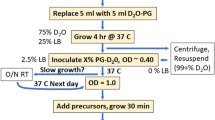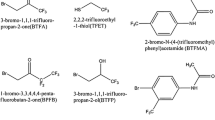Abstract
Human lysyl aminoacyl tRNA synthetase (hLysRS) is integral to a variety of different functions ranging from protein biosynthesis, initiation of a proinflammatory response as well as signal transduction. Another important, non-canonical function of hLysRS is that it chaperones tRNALys,3, the HIV-1 reverse transcription primer molecule into new HIV-1 particles. Since the N-terminal domain of hLysRS has been shown to be essential for such primer uptake, NMR studies of this domain are being conducted to obtain a better understanding of how hLysRS interacts with the primer tRNA. In order to study the RNA binding behavior of this domain, we are studying its complex with a fragment of the cognate tRNA corresponding to the tRNA anticodon loop. We report herein the backbone and side chain NMR resonance assignments of uniformly 15N-, 13C-labeled hLysRS N-terminal domain alone, as well as complexed to RNA.


Similar content being viewed by others
References
Cavanagh J, Fairbrother W, Palmer A, Skelton N, Rance M (2007) Protein NMR spectroscopy, second edition: principles and practice. Academic Press, Massachusetts
Cen S, Khorchid A, Javanbakht H, Gabor J, Stello T, Shiba K, Musier-Forsyth K, Kleiman L (2001) Incorporation of lysyl-tRNA synthetase into human immunodeficiency virus type 1. J Virol 75:5043–5048
Cen S, Javanbakht H, Niu M, Kleiman L (2004) Ability of wild-type and mutant lysyl-tRNA synthetase to facilitate tRNALys incorporation into human immunodeficiency virus type 1. J Virol 78:1595–1601
Crepin T, Perterson F, Haertlein M, Jensen D, Wang C, Cusack S, Kron M (2011) A hybrid structure model of the complete Brugia malayi cytoplasmic asparaginyl-tRNA synthetase. JMB 405:1056–1069
Delaglio F, Grzesiek S, Vuister GW, Zhu G, Pfeifer J, Bax A (1995) NMRPipe: a multidimensional spectral processing system based on UNIX pipes. J Biomol NMR 6:277–293
Francin M, Mirande M (2003) Functional dissection of the eukaryotic-specific tRNA-interacting factor of lysyl-tRNA synthetase. J Biol Chem 278:1472–1479
Francin M, Kaminska M, Kerjan P, Mirande M (2002) The N-terminal domain of mammalian lysyl-tRNA synthetase is a functional tRNA-binding domain. J Biol Chem 277:1762–1769
Frugier M, Moulinier L, Giege R (2000) A domain in the N-terminal extension of class IIb eukaryotic aminoacyl-tRNA syntheases is important for tRNA binding. EMBO J 19(10):2371–2380
Goddard TD, Kneller DG, SPARKY 3. University of California, San Francisco
Guo M, Ignatov M, Musier-Forsyth K, Schimmel P, Yang X (2008) Crystal structure of tetrameric form of human lysyl-tRNA synthetase: implications for multisynthetase complex formation. PNAS 105:2331–2336
Guzzo C, Yang D (2008) Lysyl-tRNA synthetase interacts with EF1a, aspartyl-tRNA synthetase and p38 in vitro. Biochem Biophys Res Commun 365:718–723
Jones D (1999) Protein secondary structure prediction based on position-specific scoring matrices. J Mol Biol 292:195–202
Larkin M, Blackshields G, Brown N, Chenna R, McGettigan P, McWilliam H, Valentin F, Wallace I, Wilm A, Lopez R, Thompson J, Gibson T, Higgins D (2007) ClustalW and ClustalX version 2. Bioinformatics 23(21):2947–2948
Nechushtan H, Kim S, Kay G, Razin E (2009) The physiological role of lysyl tRNA synthetase in the immune system. Adv Immunol 103:1–27
Park SG, Kim HJ, Min YH, Choi E-C, Shin YK, Park B-J, Lee SW, Kim S (2005) Human lysyl-tRNA synthetase is secreted to trigger proinflammatory response. PNAS 102(18):6356–6361
Refaei M, Combs A, Kojetin D, Cavanagh J, Caperelli C, Rance M, Sapitro J, Tsang P (2011) Observing selected domains in multi-domain proteins via sortase-mediated ligation and NMR spectroscopy. J Biomol NMR 49:3–7
Shen Y, Delaglio F, Cornilescu G, Bax A (2009) TALOS+: a hybrid method for predicting protein backbone torsion angles from NMR chemical shifts. J Biomol NMR 44:213–223
Wishart DS, Sykes BD (1994) The 13C Chemical-Shift Index: a simple method for the identification of protein secondary structure using 13C chemical-shift data. J Biomol NMR 4(2):171–180
Wishart DS, Bigam CG, Holm A, Hodges RS, Sykes BD (1995a) 1H, 13C and 15N random coil NMR chemical shifts of the common amino acids. I. Investigations of nearest-neighbor effects. J Biomol NMR 5:67–81
Wishart DS, Bigam CG, Yao J, Abildgaard F, Dyson HJ, Oldfield E, Markley JL, Sykes BD (1995b) 1H, 13C and 15N chemical shift referencing in biomolecular NMR. J Biomol NMR 6:135–140
Acknowledgments
Professor M. Rance is gratefully acknowledged for assistance with the 3D NMR experiments. The University of Cincinnati College of Medicine NMR Structural Biology Center is also acknowledged for use of their NMR instrumentation, including NIH grants RR19077 and RR027755. Professor K. Greis and the UC Proteomics facility are acknowledged for their assistance with the mass spectrometry. Funding from the University Research Council (PT, SL and AD) is acknowledged.
Author information
Authors and Affiliations
Corresponding author
Rights and permissions
About this article
Cite this article
Liu, S., Decker, A., Howell, M. et al. 1H, 13C and 15N resonance assignment of the N-terminal domain of human lysyl aminoacyl tRNA synthetase. Biomol NMR Assign 7, 289–292 (2013). https://doi.org/10.1007/s12104-012-9430-x
Received:
Accepted:
Published:
Issue Date:
DOI: https://doi.org/10.1007/s12104-012-9430-x




